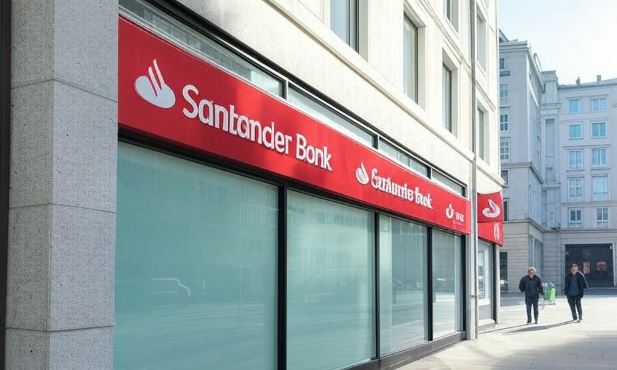In recent years, the banking landscape in the UK has undergone a significant transformation. Many high street banks are adapting to changing customer behaviours by shifting towards digital banking. One of the latest banks to make headlines for branch closures is Santander.
For years, physical bank branches have played a crucial role in communities, offering face-to-face financial services.
However, with more people now using mobile and online banking, banks like Santander are reevaluating their physical presence. This shift has raised concerns among customers, especially those who rely on in-person services.
In this article, we will explore why Santander is closing its branches, provide a full list of the affected locations, discuss the impact on customers and employees, and examine how Santander is adapting to digital banking trends.
What is Santander Bank?

Santander Bank is one of the largest financial institutions in the UK, serving millions of customers through a wide range of banking products and services.
It is a subsidiary of the Spanish banking giant Banco Santander, which operates in multiple countries across Europe and the Americas.
The bank has a strong presence in the UK, with a network of branches, ATMs, and digital banking services. It offers various financial products, including current accounts, savings accounts, loans, mortgages, credit cards, and investment solutions.
Over the years, Santander has built a reputation for providing competitive banking services while investing in technology to improve customer experience.
Santander UK was originally formed in 2010 through the merger of Abbey National, Alliance & Leicester, and Bradford & Bingley.
Since then, it has grown into one of the leading banks in the country. Despite its strong digital presence, the bank has maintained a network of branches to serve customers who prefer in-person banking.
Some of the key services offered by Santander include:
- Personal and business banking solutions
- Mortgage and loan options
- Investment and wealth management
- Digital and mobile banking services
- Customer support through branches, phone, and online platforms
With the increasing reliance on online banking, Santander has been gradually reducing its branch network over the years. The latest wave of closures is part of a broader industry trend, as banks adapt to changing customer habits.
How Does Santander Bank Work?
Santander Bank operates using a combination of traditional and digital banking services. Customers can manage their finances through branch visits, online banking, and mobile apps.
The bank has invested heavily in technology to enhance its digital services while still maintaining physical branches for essential transactions.
Key Aspects of Santander’s Banking System
- Branch Banking: Customers can visit branches for in-person services, including opening accounts, applying for loans, and financial consultations. However, with the latest closures, access to physical branches will become more limited.
- Online Banking: Santander offers a secure online banking platform where customers can check balances, transfer funds, pay bills, and manage their accounts remotely.
- Mobile Banking App: The Santander mobile app provides convenient access to banking services, including mobile deposits, transaction tracking, and secure messaging with customer support.
- ATM Services: The bank has a network of ATMs for cash withdrawals, deposits, and balance inquiries.
- Customer Support: Santander provides assistance through phone banking, live chat, and in-branch advisors for those who need personalized service.
As banking trends shift towards digital solutions, Santander has encouraged customers to explore online banking options. The branch closures are part of this transition, aimed at improving efficiency while reducing operational costs.
Why are Santander Bank Branches Closing?

The decision to close 95 branches across the UK is driven by several factors, primarily the decline in in-person banking and the increasing use of digital services.
Reasons for the Closures
- Shift to Digital Banking: More customers now prefer online and mobile banking over visiting physical branches. The demand for digital banking has grown significantly, reducing the need for a widespread branch network.
- Declining Footfall: Santander has reported a decline in branch visits as customers opt for digital transactions. This trend has been accelerated by changes in banking habits and the convenience of mobile banking.
- Cost Reduction Measures: Maintaining physical branches comes with high operational costs, including rent, staffing, and utilities. By closing underused branches, Santander can allocate resources to digital banking improvements.
- Industry-Wide Trend: Many banks across the UK, including HSBC, Lloyds, and Barclays, have also been reducing their branch networks to adapt to the changing financial landscape.
Santander has assured customers that they will continue to have access to alternative banking methods, including digital platforms and telephone banking.
However, the closures will impact those who rely on in-person banking, especially elderly customers and small businesses.
Full List of Santander Branch Closures in the UK (2025 Update)
Santander has officially announced the closure of 95 branches across the UK as part of its restructuring strategy. These closures come as the banking industry continues its shift towards digital services, with fewer people relying on physical branches for day-to-day transactions.
The move has raised concerns among customers and employees, particularly those in areas where branch banking remains essential.
The closures are set to take place in different phases, with final shutdown dates varying by location. Some branches have confirmed closure dates, while others are yet to be scheduled. Below is the complete list of branches that will be affected by these closures:
Branches with Confirmed Closure Dates
- Aberdare – 24 June 2025
- Arbroath – 17 June 2025
- Armagh – 1 July 2025
- Blackwood – 23 June 2025
- Blyth – 5 August 2025
- Bognor Regis – 14 July 2025
- Borehamwood – 1 July 2025
- Brecon – 25 June 2025
- Brixton – 11 August 2025
- Caernarfon – 7 July 2025
- Camborne – 7 July 2025
- Canvey Island – 5 August 2025
- Clacton – 16 June 2025
- Cleveleys – 23 June 2025
- Colne – 14 July 2025
- Colwyn Bay – 24 July 2025
- Crowborough – 23 July 2025
- Croydon (128 NE) – 16 June 2025
- Cumbernauld – 7 July 2025
- Didsbury – 8 July 2025
- Downpatrick – 6 August 2025
- Dungannon – 23 June 2025
- Edgware Road – 12 August 2025
- Eltham – 23 June 2025
- Exmouth – 15 July 2025
- Falmouth – 21 July 2025
- Farnham – 29 July 2025
- Felixstowe – 16 July 2025
- Finchley – 6 August 2025
- Fleet – 30 June 2025
- Formby – 11 August 2025
- Gateshead Metro – 16 June 2025
- Glasgow (LDHQ) – 24 June 2025
- Glasgow (MX) – 23 June 2025
- Greenford – 24 June 2025
- Hawick – 24 July 2025
- Herne Bay – 8 July 2025
- Hertford – 29 July 2025
- Holloway – 14 July 2025
- Holywell – 13 August 2025
- Honiton – 14 July 2025
- Kidderminster – 18 June 2025
- Kilburn – 17 June 2025
- Kirkby – 22 July 2025
- Launceston – 16 June 2025
- Louth – 17 June 2025
- Magherafelt – 24 June 2025
- Malvern – 2 July 2025
- Market Harborough – 1 July 2025
- Musselburgh – 30 June 2025
- New Milton – 28 July 2025
- Peterhead – 16 June 2025
- Plympton – 14 August 2025
- Portadown – 30 June 2025
- Pudsey – 28 July 2025
- Rawtenstall – 15 July 2025
- Ross-on-Wye – 30 July 2025
- Ruislip – 7 July 2025
- Rustington – 5 August 2025
- Saltcoats – 21 July 2025
- Seaford – 15 July 2025
- Shaftesbury – 23 July 2025
- Sidcup – 11 August 2025
- St Austell – 8 July 2025
- St Neots – 30 July 2025
- Stokesley – 31 July 2025
- Strabane – 23 July 2025
- Surrey Quays – 10 November 2025
- Swadlincote – 30 June 2025
- Tenterden – 7 July 2025
- Torquay – 17 June 2025
- Tottenham – 8 July 2025
- Whitley Bay – 6 August 2025
- Willerby – 13 August 2025
- Wishaw – 22 July 2025
Branches with Pending Closure Dates
- Bexhill
- Billericay
- Dover
- Droitwich
- Dunstable
- East Grinstead
- Holyhead
- Ilkley
- Larne
- Lytham St Annes
- Maldon
- Morley
- North Walsham
- Redcar
- Saffron Walden
- Turriff
- Uckfield
- Urmston
Customers who bank at these locations should start considering alternative banking options. Santander has encouraged customers to use online services or visit nearby branches that will remain operational.
How Many Jobs Are at Risk Due to the Closures?

The closure of 95 branches will have a direct impact on approximately 750 employees. While some of these employees may be offered roles in other Santander branches or departments, a significant number will face redundancy.
Santander has announced plans to provide support and career transition programs for affected staff. Employees may have opportunities for training and redeployment within the bank, but many will still face job insecurity.
For those impacted, the bank is also working with employment agencies to help find alternative job placements. However, given the current economic climate, these closures add to growing concerns about job losses within the banking sector.
How Will These Closures Impact Customers?
The closure of Santander branches will affect customers in different ways, particularly those who rely on face-to-face banking services.
Key Impacts
- Reduced Access to In-Person Banking: With fewer branches, customers will need to travel further for banking services, which may not be convenient for everyone.
- Challenges for Elderly and Rural Customers: Many older customers and those living in rural areas depend on branches for in-person transactions. The closures may make banking more difficult for these groups.
- Increased Use of Digital Banking: Santander encourages customers to use online and mobile banking for their everyday transactions. While this may be convenient for tech-savvy users, others may struggle with the transition.
Santander has assured customers that alternative banking options such as telephone banking and Post Office cash services will remain available to assist those affected by the closures.
What Are Santander’s Plans for Digital Banking?
Santander is focusing on enhancing its digital banking services to offer customers a seamless and efficient banking experience. The bank has already invested in its mobile app and online banking platform, which allows users to:
- Check account balances and statements
- Transfer money securely
- Pay bills and manage direct debits
- Apply for loans and mortgages online
- Chat with customer service representatives via live chat
With these improvements, Santander aims to provide a better digital banking experience while reducing reliance on physical branches.
How Does Santander Compare to Other UK Banks?

Santander is not the only bank reducing its branch network. Other major UK banks have also announced closures in response to the growing shift towards digital banking.
- Lloyds Bank: Recently announced the closure of multiple branches across the UK.
- Barclays: Continues to reduce its high street presence, focusing on digital banking.
- HSBC: Has been actively shutting branches and investing in digital solutions.
The trend is clear, most UK banks are adapting to changes in consumer behaviour by prioritizing digital banking over maintaining costly branch networks.
What Should Santander Customers Do Next?
If your branch is closing, consider these steps:
- Visit another Santander branch if possible.
- Sign up for online and mobile banking for easier access to banking services.
- Use telephone banking for inquiries and assistance.
- Use Post Office services for basic banking transactions.
For further assistance, customers can contact Santander’s customer support team for guidance on alternative banking options.
Conclusion
Santander’s decision to close 95 branches marks a significant shift in the UK banking sector. While the move is driven by the rise of digital banking, it raises concerns about accessibility for certain customers.
The closures will impact thousands of people, from employees facing job losses to customers who prefer in-person banking. Santander has committed to supporting affected customers with alternative services, but the transition may still be challenging for some.
As banking continues to evolve, customers are encouraged to explore digital banking options and stay informed about the latest changes in the industry.
FAQs
Is my local Santander branch closing?
You can check Santander’s official website or contact customer support to find out if your local branch is affected.
What alternatives do I have if my branch closes?
Santander customers can use online banking, mobile banking, telephone banking, and Post Office services for their transactions.
Will the branch closures affect my account?
No, your account will remain active, and you can continue using Santander’s banking services.
How will staff be affected by the closures?
Around 750 jobs are at risk, with some employees being redeployed and others facing redundancy.
Why is Santander shifting to digital banking?
The decline in branch visits and the growth of online banking have led Santander to focus on digital banking solutions.
Can I still get in-person customer support?
Yes, you can visit remaining branches, contact Santander via phone, or use live chat for assistance.









